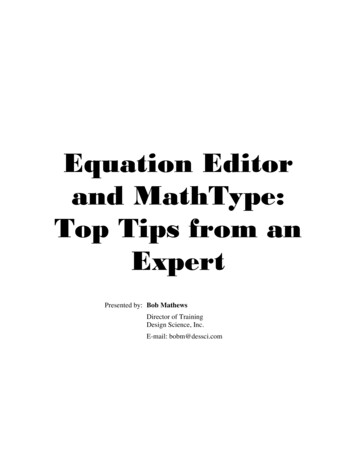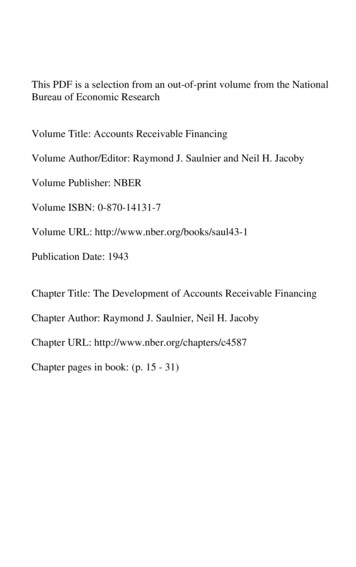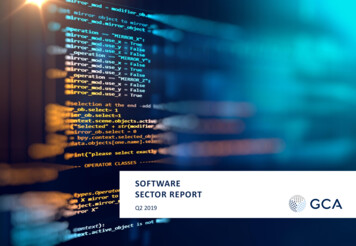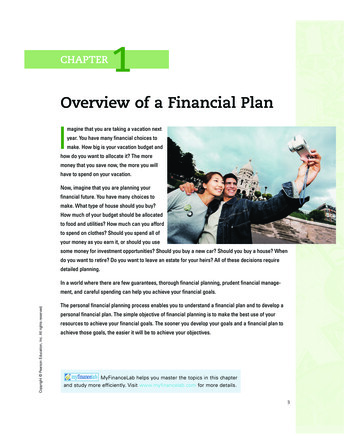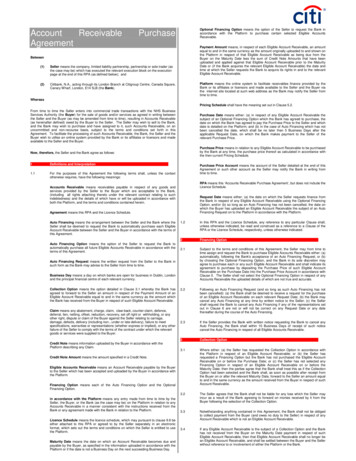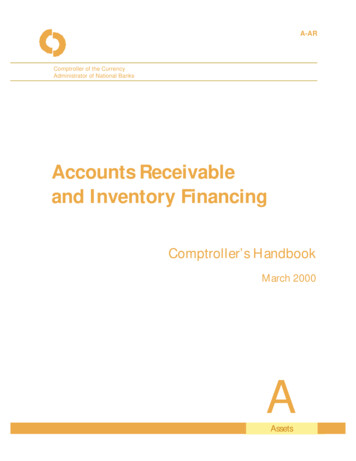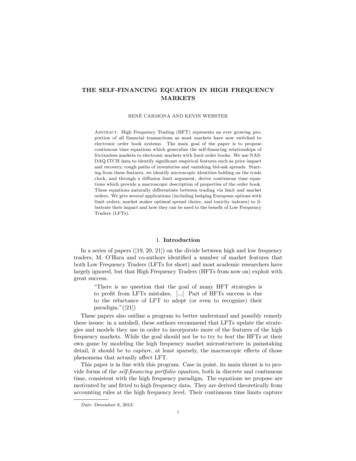
Transcription
THE SELF-FINANCING EQUATION IN HIGH FREQUENCYMARKETSRENÉ CARMONA AND KEVIN WEBSTERAbstract. High Frequency Trading (HFT) represents an ever growing proportion of all financial transactions as most markets have now switched toelectronic order book systems. The main goal of the paper is to proposecontinuous time equations which generalize the self-financing relationships offrictionless markets to electronic markets with limit order books. We use NASDAQ ITCH data to identify significant empirical features such as price impactand recovery, rough paths of inventories and vanishing bid-ask spreads. Starting from these features, we identify microscopic identities holding on the tradeclock, and through a diffusion limit argument, derive continuous time equations which provide a macroscopic description of properties of the order book.These equations naturally differentiate between trading via limit and marketorders. We give several applications (including hedging European options withlimit orders, market maker optimal spread choice, and toxicity indexes) to illustrate their impact and how they can be used to the benefit of Low FrequencyTraders (LFTs).1. IntroductionIn a series of papers ([19, 20, 21]) on the divide between high and low frequencytraders, M. O’Hara and co-authors identified a number of market features thatboth Low Frequency Traders (LFTs for short) and most academic researchers havelargely ignored, but that High Frequency Traders (HFTs from now on) exploit withgreat success.“There is no question that the goal of many HFT strategies isto profit from LFTs mistakes. [.] Part of HFTs success is dueto the reluctance of LFT to adopt (or even to recognize) theirparadigm.”([21])These papers also outline a program to better understand and possibly remedythese issues: in a nutshell, these authors recommend that LFTs update the strategies and models they use in order to incorporate more of the features of the highfrequency markets. While the goal should not be to try to beat the HFTs at theirown game by modeling the high frequency market microstructure in painstakingdetail, it should be to capture, at least sparsely, the macroscopic effects of thosephenomena that actually affect LFT.This paper is in line with this program. Case in point, its main thrust is to provide forms of the self-financing portfolio equation, both in discrete and continuoustime, consistent with the high frequency paradigm. The equations we propose aremotivated by and fitted to high frequency data. They are derived theoretically fromaccounting rules at the high frequency level. Their continuous time limits captureDate: December 8, 2013.1
2RENÉ CARMONA AND KEVIN WEBSTERthe relevant effects at the macroscopic level. From these fundamental relationships,we use the powerful tools of stochastic calculus to revisit the solutions of a certainnumber of standard continuous time financial problems in light of the new highfrequency paradigm. We show how the latter affects for example option hedgingand we highlight the different solution depending upon trading being through limitorders versus market orders. A model for market making in the spirit of [7] issolved. We also introduce, still in the same framework, an instantaneous and acumulative toxicity indexes in the spirit of [21].The crucial insight of [21], named ’the new paradigm’, is the fact that highfrequency traders do not operate on the ’calendar’ clock, but instead use some formof ’event-based time’, such as the trade clock, or the volume clock. This is partlydue to the algorithmic nature of their strategies and the lack of direct calendarclock dependent constraints such as maturities and the likes. A fringe benefit forquantitative analysis is the well documented fact that prices behave better under anevent-based clock than the calendar clock. A number of papers [6, 14, 15, 29, 30, 21]argue that, in addition to removing seasonal effects and resolving asynchronicityissues, this time-change makes the price returns more Gaussian-like. Even thoughthis property is mostly irrelevant in our analysis, we choose to work in the tradeclock in which each discrete time step corresponds to one trade. Indeed, eventhough our conclusions are independent of the clock used, we find the trade clockespecially convenient to formulate and test the significance of our findings. Withthese proviso out of the way, we can outline our research agenda:(1) Understand, at the microscopic level, structural relationships and strategiesthat HFTs exploit;(2) Identify which features persist at the macroscopic level, in which form, andprovide continuous time models on that scale;(3) Use these models to update LFT strategies and provide monitoring tools:transaction cost analysis, measure of toxicity of order flow, . . .For the sake of definiteness, we focus on the self-financing portfolio equation ofcontinuous time finance. To this effect, we review in Section 2 the role of thiscondition in quantitative finance, and in so doing, introduce the continuous timeanalysis notation used in the paper, as well as the exact form of our generalization.The main originality of the form of the self financing condition which we proposeto use, is the fact that it accounts for both price impact and price recovery, twoimportant empirical microstructure features that are usually ignored or modeledin separate ad-hoc fashions. It also differentiates between the impacts of limit andmarket orders. This is important because nowadays, a large number of agentstrade with both types of orders, rather than simply relying on market makers tofind trades. Furthermore, our generalization of the self-financing portfolio equationcan be used with a larger class of inventories models, e.g. with infinite variation.This allows the use of the powerful tools of stochastic calculus to retain tractabilityin a number of models.The classical self-financing portfolio equation was generalized in two separatedirections in the financial engineering literature. On one hand, Almgren and Chrissproposed in [4] a way to incorporate price impact and temporary transaction costsin a phenomenological model for optimal execution with market orders and finitespeed of trading. On the other hand, and with a completely different point of view,
THE SELF-FINANCING EQUATION IN HIGH FREQUENCY MARKETS3extensions of the classical self-financing equation of the Black-Scholes theory weretouted by researchers attempting to include transaction costs in Merton’s optimalportfolio’s theory. See for example [13, 28, 36] or the recent review [27].Two books, Empirical market microstructure by J. Hasbrouck ([23]) and Marketmicrostructure theory by M. O’Hara ([34]) cover the state of the field prior tothe advent of HFT. They contain informed trader models ([26]) and inventorybased market making ([5, 22, 24, 35]). Three main themes united different marketstructures at that time: the limit order book, adverse selection (the underlyingcause of price impact) and statistical predictions. These themes are just as relevant,if not more so in the new age of high frequency trading.Our investigations were inspired by a large number of empirical studies of highfrequency data (see for example [8, 9, 10, 12, 32, 38, 39, 40]), and recent publicationsof theoretical models of the limit order book ([16, 17, 18, 31, 39]). However, ouremphasis is different as we use limit orders as a starting point. Our goal is not toexplain the evolution of the order book, but merely to analyze the consequencesof the choices made by the liquidity providers and takers on price changes, theirinventories and their wealth.We close this introduction with a short overview of the paper. Since so muchof our motivation and results depend upon the self financing condition, we devotenext section to a review of the role of this condition in continuous time quantitativefinance, with the goal of introducing the notation used in the paper, as well asannouncing the exact form of our generalization. The remainder of the paper isstructured into two parts. In the first part, we consider limit order books on whichthe trades take place at the best bid and best ask only. While seemingly restrictive,this assumption can be justified by looking closely at the data. Indeed, once twospecific classes of executions are removed from the data 1, this assumption holds truein all the experiments reported in this paper. In the second part of the paper, werefrain from pre-processing the data in this way and we consider the case of a generalorder book. For the sake of completeness we derive the self-financing equations fora general order book shape. This generalization is needed for markets where asignificant amount of trades happen outside the bid-ask spread. As expected, thispart of the paper is more involved mathematically.We first derive discrete versions of our self financing equation and of the priceimpact constraint from NASDAQ limit order book data. Our empirical studies aredone in the trade clock, and we demonstrate the significance of our microscopicanalysis by rigorous statistical tests. Next we take the limit as the tick size goesto zero, and obtain diffusion limits for both price and trade volumes. This leads toour proposed macroscopic continuous-time self-financing condition.1We removed two specific classes of trades: 1) executions classified by NASDAQ as type ’C’.While we were not able to figure out what these special deals are, their numbers are very small,and on any given day, for any given stock, these executions represent less than 1% of the trades;2) executions of hidden orders. While in very small numbers, if at all present, for small cap stocks,these trades are frequently very significant for large cap stocks. For example, on many days, theproportion of executions of hidden orders can be as large as 35 to 40% of the trades for stocks likeApple or Google. Moreover, no information is provided as to whether the execution is for a fullyhidden order, or a the tip of an iceberg order. So, we decided to remove these executions for thepurpose of this first empirical study of the self-financing condition from the order book.
4RENÉ CARMONA AND KEVIN WEBSTERWe propose several applications of these macroscopic equations. We first revisitlocal volatility models for European options in our framework and obtain hedgingstrategies via limit or market orders. As a highlight, we show that limit orderscan only hedge negative convexity options while market orders can hedge positiveconvexity options. This is a rare example where the theory naturally distinguishesbetween the roles of liquidity providers and liquidity takers. Then a model for highfrequency market making is presented to uncover the relationship between optimalspread setting and price volatility. Finally, we propose two forms of toxicity ofmarket order flow in our continuous time setting, and for the sake of illustration,we compute their empirical analogues on the pool of 120 stocks used in a recentECB study of HFT. Following our theoretical analysis of general order book shapes,we propose for illustrative purposes, a supply and demand model based on perfectfill rates and deterministic price recovery.2. The self-financing equationIn quantitative finance, the standard self financing portfolio equation is a cornerstone of the theory of frictionless markets. It plays a crucial role in manyfundamental results, e.g. Merton’s portfolio theory. Mathematically, speaking it isa simple equation which constrains the wealth process of an investor to live in acertain sub-space. This sub-space is therefore often called the space of admissibleportfolios. New-comers to the mathematical theories of financial market often gripewith the self-financing condition and how it relates to the real world. While it canbe postulated as a mathematical definition, it can also be derived from a limitingprocedure starting from accurate descriptions of the microstructure of trades in thetrade clock. This approach is at the core of our strategy.“The sad fact is that the self-financing condition is considerablymore subtle in continuous time than it is in discrete time.”2When discussing market models at the macroscopic level, we assume that themid-price p and the inventory L are given by Itô processes:(dpt µt dt σt dWt(2.1)dLt bt dt lt dWt0for two Wiener processes W and W 0 with unspecified correlation structure. Weshall also consider an adapted process st representing (in the continuous time limit)the bid-ask spread measured in tick size. The standard self-financing condition ofcontinuous time finance can be stated as a constraint:dXt Lt dpt(2.2)between the price p of the underlying interest, the inventory L, and the wealth X ofthe agent. In most classical financial applications, case in point Merton’s portfoliotheory, the price p is exogenously given, the inventory L is the agent’s input, andhis wealth X appears as the output of equation (2.2).The objective of this paper is to generalize the self-financing portfolio condition(2.2) to incorporate known idiosyncrasies of the high frequency markets includingtransaction costs, price impact and price recovery. Also, we want this generalizationto be able to quantify the differences between trading via limit orders and market2J. Michael Steele, Stochastic Calculus and Financial Applications, section 14.5 ’Self-financingand self-doubt’.
THE SELF-FINANCING EQUATION IN HIGH FREQUENCY MARKETS5orders. We warn the reader that the equations proposed in this paper are onlynecessary conditions and that quantifying limit order fill rates, priorities and pricerecovery are beyond the immediate scope of the present paper.2.1. Our basic formula. The empirical analysis of NASDAQ order book datagiven in Section 3 and in the Appendix, together with the diffusion limit argumentsof Section 4, prompt us to formulate the self-financing condition in the followingform:st ltdXt Lt dpt dt d[L, p]t(2.3)2πwhere is when trading with limit orders, and when trading with marketorders. Indeed, we show in Section 3 below that, when time is measured in thetrade clock, the discrete time analog of formula (2.3) can be derived rigorouslyfrom a specific limit order book feature, and matches real wealth data extremelyaccurately. We shall also impose the constraintd[L, p] 0(2.4)whenever trading with limit orders. Again, this adverse selection constraint is alsodictated by the empirical analysis of the NASDAQ data.We now explain how our condition (2.3) and the adverse selection constraint(2.4) relate to the conditions used in the separate sets of works reviewed in theintroduction.2.2. The Almgren-Chriss model. The seminal work by Almgren and Chriss [4]addresses a question closely related to ours. These authors propose a macroscopicmodel for the price impact and the change of wealth after a liquidity taker’s decision.The model leads to a very tractable framework which was used by many optimalexecution studies (see [2, 33] for example). This framework can be summarized bythe system: dpt ft (lt )dt σt dWt(2.5)dLt lt dt dXt Lt dpt ct (lt )dtwhere f and c are two function-valued adapted processes which are positive, andin the case of c, convex.The main advantage of this model is that price impact appears in a tractablefashion. Indeed, it comes through the function ft , which creates a positive ‘correlation’ between traded volumes and the price process. However, it constrains L tobe differentiable and for this reason, the model parameters cannot be calibrated tomarket data directly, making the model difficult to test empirically. As the empirical analysis of NASDAQ data reported in Section 3 and the appendix shows, thereis ample evidence supporting nondifferentiable inventories. Moreover, limit ordersare not part of the discussion in the Almgren-Chriss framework.2.3. Transaction cost literature. The branch of classical mathematical financemost related to our paper is portfolio selection under transaction costs ([13, 28,36] or the recent review [27]). Most of these works start from a model for thewealth of a liquidity taker which generalizes the self-financing equation to a settingwith transaction costs. In general however, these papers do not emphasize thederivation of the model, but instead, the study of its consequences. We hope to
6RENÉ CARMONA AND KEVIN WEBSTERappeal to this side of the community by providing more accurate equations for selffinancing portfolios while keeping similar tractability, leading the way to problemsrelated to liquidity provision, such as market making. An interesting feature ofsuch problems is that the agent does not directly control his portfolio, adding anadditional modeling challenge. For the record we note that the standard equationused in this branch of the literature isst(2.6)dXt Lt dpt dL t2Rtwhere again, the inventory process L is assumed to have finite variation 0 dL s for all finite t and st is the bid-ask spread.Strengths of this model are its simplicity, relative tractability, and straightforward calibration to the market. Its weaknesses include the fact that the processL can only have finite variation. Moreover, price impact, limit orders and othermicrostructure considerations are absent in the model.Formula (2.6) is much closer to our proposed equation (2.3) than it may seemat first. It merely corresponds to a different diffusion limit. It can be recoveredin our framework by considering non-vanishing bid-ask spread, zero price impactand looking at market orders only. Notice that these assumptions may be morenatural than ours for low frequency markets. This is presumably the reason fortheir introduction.3. Empirical study and discrete equationsWe first recall standard terminology from the high frequency markets.3.1. High frequency terminology. Trading on high frequency markets takesplace on an object called the limit order book. An agent can interact with othersvia two possible trading mechanisms: limit orders and market orders. Limit orderscorrespond to the act of providing liquidity to the market, while market orders takeliquidity from it. We will refer to agents who engage in the first type of trade asliquidity providers 3 while traders who trade with market orders will be referred toas liquidity takers. In real markets, traders often switch between liquidity providingand taking strategies, blurring this definition somewhat. The following commentscan help highlight the differences. A liquidity taker pays a fee for his aggressiveness. This fee typically takesthe form of the bid-spread, which is where most trades happen. The corresponding provider captures this bid-ask spread. Right after the trade happens, the price may move. If it does, it almostalways moves in favor of the market order, compensating to some degreethe transaction costs. This phenomena is called price impact. It is a consequence of the adverse selection of limit orders by takers. Between two successive trades, the price reverts to some value in betweenthe impacted price and the original one. Price recovery is an intuitive nameoften used to describe this high frequency feature. Takers control their inventory directly. Attaining correlation with the market requires high frequency predictions of the next price move.3Of which market makers are a special class.
THE SELF-FINANCING EQUATION IN HIGH FREQUENCY MARKETS7 Providers do not directly control their inventory, but only their exposure tothe flow of market orders. How much of the flow they are able to capturedepends on their limit order fill rate. Flow is considered toxic if it leads toadverse selection. The profitability of a provider’s strategy depends on thespread he captures and the toxicity of his flow.3.2. Data used in the Study. The statistical tests reported in this paper wereproduced by the analysis of the NASDAQ ITCH data of, amongst other stocks, thepool of 120 stocks used in the recent ECB study [11] of high frequency trading. Thefigures included in this paper were produced using the data for Coca Cola (KO) on18/04/13 . As explained in an earlier footnote, the only cleaning pre-processing ofthe raw data was to remove the special deals and the executions of hidden orders.The data do not contain the identity of the agents involved in the transactions.For that reason, all quantities relating to the inventory L, cash K or wealth X areaggregate quantities which could be thought of as relating to a representative aggregate liquidity provider. The mid-price will be denoted by p and the bid-ask spreadby s. The time stamps of the transactions are measured in fractions of microseconds and given in the calendar clock. However, the data analysis is performed inthe trade clock n 1, .N where each time step corresponds to one trade time. Forexample, pn ptn ptn where tn is the n-th trading time in the calendar clockgives the mid-price just before the n-th transaction. Limit order data happeningbetween two trade times is the source of the changes in the best bid and best ask,(and consequently of the mid-price) and is discarded for the purpose of our analysis.More generally, if Y is a discrete process, we denote by n Y the forward-lookingincrement n Y Yn 1 Yn .3.2.1. More Notation. We denote by sn the bid-ask spread just before the n-thtrade. In other words, sn is the difference between the best ask and the best bid,just before the n-th trade. We shall argue later on that the spread is of the sameorder of magnitude as the change in price, namely that sn n p . We alsoFigure 1. Plots of the best bid, best ask and mid-price as functions of trade time (left). Zoom into a part of the graph to see thedifferences between the three plots (right).denote by Ln and Kn the inventory and the cash held by the aggregate liquidityprovider just before the n-th trade. These quantities are not given explicitly with
8RENÉ CARMONA AND KEVIN WEBSTERthe data provided by NASDAQ, but starting from L0 K0 0, they can easily becomputed after each trade. Indeed, Ln is the cumulative sum up to time n of thealgebraic volumes of the trades (positive volume for a limit order executed againsta sell market order, and negative volume for an execution against a buy marketorder). Similarly, Kn is the cumulative sum up to time n of the cash exchangedduring the trades. The inventory and the cash Ln and Kn held by the aggregateliquidity provider are plotted in Figure 2 against the trade time n.Figure 2. Coca Cola (KO) stock on 18/04/13. Inventory, cashand wealth are those of the aggregate liquidity provider.3.3. Price impact. Empirically, price impact is the simple fact that the pricemoves after each trade, and tends to move in favor of the market order. There havebeen several empirical studies and multiple proposed measures and models for it([2, 4, 9, 10, 12, 32, 33, 38, 39]). The main economic interpretation for price impactis adverse selection. In this study, we isolate, measure and model price impact by
THE SELF-FINANCING EQUATION IN HIGH FREQUENCY MARKETS9a straightforward relationship. n L n p 0.(3.1)For all n 1, .(N 1). This relationship states that the price cannot move upwhen the liquidity provider has bought and cannot move down when the providerhas sold. From the taker’s perspective, this means that the price always moves inhis favor right after a trade.We provide rigorous statistical tests of (3.1) in Appendix A. For the sake ofillustration, we note that for Coca Cola on April 18, 2013, (3.1) holds for all but166 of the 20742 trades of our streamlined data set, which represents 0.9% of thetrades. This trade impact relationship has clear consequences for the continuoustime analogs of the discrete model considered here: the quadratic covariation between the provider’s inventory and the price process is negative and decreasing.Conversely, the quadratic covariation between the inventory of a liquidity takerand the price process is positive and increasing.Figure 3. Quadratic covariation between inventory and price path.Price impact will give us an extra compelling reason to accept trade volumeswith infinite variation. Indeed, when using continuous time models, if the pricepath and the inventory have a non-negligible quadratic covariation, then we cannotmodel one as a diffusion process and the other as a finite variation process.Remark 3.1. The causality of price impact is unclear: do trades cause price movements, or simply predict them? While not crucial for the mathematical theory, it
10RENÉ CARMONA AND KEVIN WEBSTERis important for interpretation purposes, and we choose to use the second option.In particular, we shall say that a liquidity taker whose changes in inventory arestrongly correlated with the price movements has a very good short term predictionof the price. This typically is the case of sophisticated high-frequency traders. Lowfrequency traders, on the other hand, trade more slowly and acquire inventorieswhich aren’t directly correlated with the smaller price movements.3.4. Price recovery. This is another simple observation. Trades move prices, buttypically move them at most by one bid-ask spread. If they systematically movedthe price by one bid-ask spread, then the correlation between the price path and thetaker inventory should be one. Otherwise, it is smaller than one and we say thatthe price has recovered from the price impact. Note that, of all our relationships,this is statistically the weakest one: it is not verified for 5% of the Coca Cola data.Figure 4. Relationship between price increments and spread.Mathematically, this implies that n p sn for n 1, .(N 1). In thecontinuous time version considered later, it will provide in the diffusion limit anupper bound on instantaneous price volatility based on the current spread.3.5. A bit of accounting. Finally, we derive the self-financing portfolio equationfrom first principles in such a high frequency market.Because after removing the special deals and the executions against hidden orders, all the trades do happen at the best bid or ask, the amount of cash exchangedis equal to( (p s2n ) n L if n L 0(3.2) n K (p s2n ) n L else
THE SELF-FINANCING EQUATION IN HIGH FREQUENCY MARKETS11That is, the provider pays the bid (resp. receives the ask) when he buys (resp.sells). This can be summarized by the equation:sn n K pn n L n L (3.3)23.5.1. The aggregate liquidity provider’s wealth. We define wealth asXn pn Ln Kn(3.4)that is, the cash held by the liquidity provider plus the value of her inventorymarked to the mid-price. The wealth Xn of the aggregate liquidity provider isplotted in Figure 2 against the trade time n.3.5.2. The discrete self-financing equation. We derive the dynamics of the wealthprocess X from equations (3.3) and (3.4): n X Ln n p pn n L n p n L n Ksn Ln n p n L n p n L2(3.5)3.5.3. Empirical validation. We compare four quantities: 1) the actual wealth, 2)the wealth computed from the standard self-financing equation: n X Ln n p(3.6)used in the classical Black-Scholes option pricing and Merton portfolio theories, 3)the wealth computed from the standard self-financing condition:sn n X Ln n p n L (3.7)2advocated to include transaction costs in Merton’s theory of optimal portfoliochoice, and finally 4) the wealth computed from our self-financing condition (3.5).The plots of these four wealth processes are given in Figure 5 for Coca Cola stockon April 18, 2013. Changing stock or changing day does not seem to affect the following facts which are easily illustrated in this figure. The wealth computed fromthe standard self-financing equation of the Black-Scholes theory clearly underestimates the actual wealth of the aggregate liquidity provider The wealth computedfrom the classic equation (3.7) tries to correct for the lack of transaction cost, but itover-shoots and over-estimates the wealth of the aggregate liquidity provider. Theerror is reduced and practically canceled by including the adverse selection termgiven by the quadratic covariation, and using our proposed formula (3.5). Thequadratic covariation between inventory and price matters!3.5.4. Recovering the frictionless case. A surprising property worth mentioningconcerns the case sn 0. Indeed, the latter does not correspond to the frictionless case. Rather, choosing price jumps n p sn /2 and using the fact thatthe price impact is negative, i.e. n L n n L n , yields the identitysn n X Ln n p n L n p n L Ln n p2which is the standard self-financing portfolio equation. In our high frequency framework, it is not the absence of transaction costs that corresponds to the frictionlesscase, but rather the absence of price-recovery, for in that case, the price impactexactly compensates the transaction costs.
12RENÉ CARMONA AND KEVIN WEBSTERFigure 5. Plots of the actual wealth of the aggregate liquidityprovider (as in Figure 2) together with the wealth computed fromthe three self-financing conditions. Red is the frictionless case.Green corresponds to (3.7). The actual wealth and the wealthcomputed from our self-financing condition (3.5) are indistinguishable on the graph.3.6. Summary. Our empirical evidence suggests the following equations and features for the inventory L and wealth X of a liquidity provider, the bid-ask spreads and the price p:3.6.1. Self-financing equation. n X Ln n p sn n L n p n L2(3.8)3.6.2. Price impact (adverse selection). n L n p 0(3.9) n p sn(3.10)3.6.3. Price recovery.
THE SELF-FINANCING EQUATION IN HIGH FREQUENCY MARKETS133.6.4. Vanishing bid-ask spread. sn and n p are of the same order of magnitude,namely sn n p .4. Continuous equation: Bid-Ask caseThe aim of this section is to derive formula (2.3) from its discrete version (3.8)established in the previous section. In the process, we shall also derive continuoustime analogs of the price impac
In a series of papers ([19, 20, 21]) on the divide between high and low frequency traders, M. O’Hara and co-authors identi ed a number of market features that both Low Frequency Traders (LFTs for short) and most academic researchers have largely ignored, but that High Frequency
